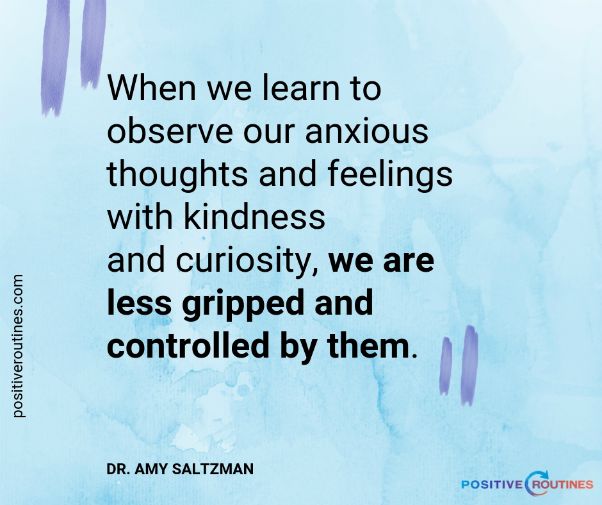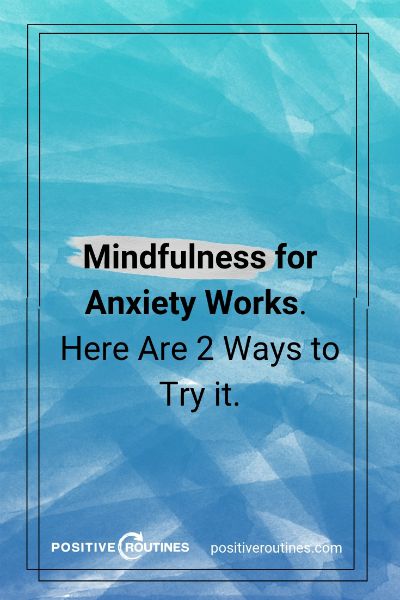Ever try mindfulness for anxiety? Ever feel anxiety just seeing the word “anxiety”? If your heart rate just skyrocketed and you feel the sweats coming on, you’re in the right place. And truthfully, even if you didn’t, it’s worth sticking around. Why? Because more of us struggle with anxiety than you think, and many of us will encounter it at some point in our lives. In light of this, having a method to take on your anxious is a good idea. Having a method that actually works is an even better one. And trust us, mindfulness meditation for anxiety is one of them.
Before we get into how to use mindfulness for anxiety, let’s take a look at just how common anxiety is. Then we’ll share insights from an expert on why it works and how to get started and give you a 10-minute guided meditation for anxiety relief.
Not sure what mindfulness is? Start with our beginner’s guide to mindfulness for definitions and more info on the science behind it.
Wait, How Common is Anxiety Really?

First off, when we’re talking about anxiety, we mean clinical, diagnosable anxiety, not everyday stress. Don’t get us wrong; stress sucks too. But there is a difference between them. The Anxiety and Depression Association of America explain it like this:
…stress is a response to a threat in a situation. Anxiety is a reaction to the stress.”
Lots of us deal with anxiety, so you’re not alone if you do too. Here are some quick anxiety facts:
- Nearly 20 percent of adults in the US have struggled with an anxiety disorder over the past year.
- This means that anxiety is the most common mental health issue in the country.
- Almost a third of us (31 percent) will have an anxiety disorder over the course of our lives, estimates the National Institutes of Health.
If you’re struggling with anxiety, or think you might be, talk to your healthcare provider about treatment options. Therapy helps. And combined with other at-home strategies, you may find some relief.
Mindfulness is one of those strategies, and there’s real science behind it. In a meta-analysis of 209 studies of Mindfulness-Based Therapy, researchers found that mindfulness was just as effective for treating psychological problems as other interventions including cognitive behavioral therapy and medication. The researchers concluded that
(Mindfulness Based Therapy) is an effective treatment for a variety of psychological problems, and is especially effective for reducing anxiety, depression, and stress.”
Why Mindfulness for Anxiety Works

We connected with Dr. Amy Saltzman, physician and mindfulness coach, who shared her insights on why using mindfulness for anxiety works.
1. There are different ways to define mindfulness. What’s yours?

“Mindfulness is paying attention here and now, with kindness and curiosity so that we can choose our behavior. When we learn to observe our anxious thoughts and feelings with kindness and curiosity, we are less gripped and controlled by them; we can simply watch them arise and pass away, without believing them or taking them personally.”
Doesn’t that sound amazing—to be less gripped and controlled by our anxious thoughts? Mindfulness allows you to observe rather than become attached. But you won’t get those big benefits from just one go; it’s a skill that takes some time to develop. When done regularly, mindfulness can reduce the thoughts and feelings associated with anxiety.
2. How can mindfulness help with anxiety?

“Often people with anxiety are anxious about feeling anxious. Unfortunately, when people worry about being anxious this may increase both the frequency and intensity of their anxiety.
“When a person with anxiety learns to observe their anxiety with kindness and curiosity [i.e., practice mindfulness] …then they can actually be relaxed with being anxious. Then they only have the original anxiety, not all the stress of trying to get rid of the anxiety.
“Over time they learn it is okay to feel anxious, and then interestingly they are less anxious.”
2 Mindfulness Meditation Exercises to Ease Anxiety

1. Learn to accept what you feel

Here’s a mindfulness for anxiety exercise adapted from Dr. Saltzman’s book, Still Quiet Place for Athletes: Mindfulness Skills to Achieve Peak Performance and Find Flow in Sports and in Life. This is all about taking a look at how you feel with curiosity and kindness, instead of judgment. Ready to try?
- Step 1: Get into a comfortable position. Take deep belly breaths. Sit in the silence for a moment.
- Step 2: Pay attention to how you’re feeling. Give those feelings a name.
- Think adjectives like irritated, excited, thrilled, disappointed, and so on. Don’t be afraid to give them stranger or more specific names like feisty, bubbly, or demure.
- Some of those feelings might be bigger and others might be smaller. That’s totally okay.
- Step 3: Figure out where the feeling resides in your body and what it feels like. Does it feel heavy on your chest? Make your head pound? Your stomach churn? Keep your focus on the feeling instead of your thoughts about it. Go back to your breath if you struggle here.
- Step 4: Does the feeling have a color, like maroon, aquamarine, or forest green? If yes, describe it, and if not, try to imagine one. If you can’t, that’s okay too.
- Step 5: Try to see if the feeling has a sound. Maybe this feeling laughs, moans, sobs, or sighs. If the feeling doesn’t have a sound, that’s okay.
- Step 6: To finish the meditation, pay attention to how you feel now—in your body and your mind. And give yourself a big congrats for just observing how you feel, instead of judging. Remember, you can do this any time you want.
- Step 7: Take a few deep breaths, open your eyes, and go about your day.
2. Follow a 10-minute guided meditation video
Find it difficult to do a meditation solo? That’s okay. Option two provides a little more help.
Try this easy guided meditation for anxiety relief with our meditation instructor and psychotherapist, Grace Fisher.
Repeat often for maximum benefits

We know that anxiety sucks, but mindfulness is a simple, yet powerful way to navigate the thoughts and feelings that come along with it. Take a few minutes every day this week to feel those feelings, whatever they are, and see what happens. You might just find yourself less anxious.
For more ways to take on your anxiety, check out these exercises based on positive psychology.
Your turn: Ever used mindfulness for anxiety relief? Share your experience in the comments.
If you like this article, you’ll also like These Mindfulness Meditation Exercises Will Change Your Day

Author: Sara Robinson
Sara Robinson has a Master’s Degree in Sport Psychology, though her passion is for the psychology of performance rather than an actual interest in sport. She’s a writer, content manager, project manager, and mom of 2 young boys, which means she’s constantly managing something or someone. If you’re a busy working mom, find out how to create more balance over on her blog, Get Mom Balanced.

Let Us Know What You Think